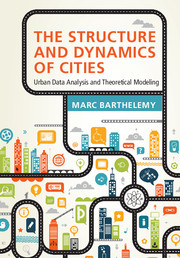Book contents
6 - Multimodality in cities
Published online by Cambridge University Press: 10 November 2016
Summary
In the previous chapter, we discussed the analysis and modeling of mobility patterns in cities. However, as cities expand, their transportation networks are also growing, with increasing interconnections between different transportation modes. In large cities, we can now choose the transportation mode to travel from one point to another, and this trip can even involve several different modes. This multimodality is a new aspect of large cities and brings new questions and problems. From the users, point of view, it becomes difficult to deal with the huge amount of information needed for describing the different transportation networks and their interconnections. From the transport agencies point of view, the managing task becomes harder because the different modes are usually run by separate agencies; this renders optimization difficult owing to the large number of aspects that have to be taken into account (Guo and Wilson 2011).
In particular, an important problem concerning multimodality is the synchronization between different modes. For example, on average in the UK, 23% of travel time is lost in connections for trips with more than one mode (Gallotti and Barthelemy, 2014). This lack of synchronization between modes induces differences between the theoretical quickest trip and the “time-respecting” path, which takes into account waiting times at interconnection nodes.
In order to address these problems and more generally to understand the impact of the coupling between modes, we need new tools in order to identify the main factors that govern their efficiency. The multilayer network approach seems to be the most convenient framework for studying these systems (Kivel ä et al. 2014; Boccaletti et al. 2014). In this framework, each layer represents a mode and intermodal connections are represented by inter-layer links. In this chapter we discuss some aspects of multimodality and present tools for measuring and characterizing these coupled networks and their efficiency as a whole.
A multilayer network view of urban navigation
Empirical observations of multimodality
We first describe empirical results obtained by Gallotti and Barthelemy (2014) from timetables for the whole UK and for all transport modes. We note that these results were not obtained for traffic data (that are usually difficult to get). Instead we used these timetable data and the assumption of uniform demand.
- Type
- Chapter
- Information
- The Structure and Dynamics of CitiesUrban Data Analysis and Theoretical Modeling, pp. 161 - 192Publisher: Cambridge University PressPrint publication year: 2016



